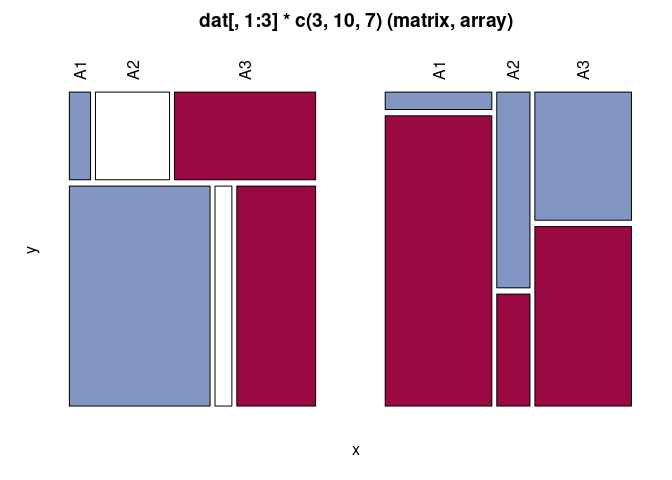@nirgrahamuk gave the dplyresque; here is a more succinct version that does not rely on dplyr other than generating the motivating data.
dat <- as.matrix(dplyr::tribble(~A1, ~A2, ~A3,
2, 3, 4,
10, 4, 8))
mult_by <- c(3,10,7)
DescTools::Desc(dat[,1:3]*c(3,10,7))
#> ------------------------------------------------------------------------------
#> dat[, 1:3] * c(3, 10, 7) (matrix, array)
#>
#> Summary:
#> n: 235, rows: 2, columns: 3
#>
#> Pearson's Chi-squared test:
#> X-squared = 55.283, df = 2, p-value = 9.896e-13
#> Log likelihood ratio (G-test) test of independence:
#> G = 61.144, X-squared df = 2, p-value = 5.285e-14
#> Mantel-Haenszel Chi-squared:
#> X-squared = 32.913, df = 1, p-value = 9.639e-09
#>
#> Phi-Coefficient 0.485
#> Contingency Coeff. 0.436
#> Cramer's V 0.485
#>
#>
#> A1 A2 A3 Sum
#>
#> A freq 6 21 40 67
#> perc 2.6% 8.9% 17.0% 28.5%
#> p.row 9.0% 31.3% 59.7% .
#> p.col 5.7% 63.6% 41.7% .
#>
#> B freq 100 12 56 168
#> perc 42.6% 5.1% 23.8% 71.5%
#> p.row 59.5% 7.1% 33.3% .
#> p.col 94.3% 36.4% 58.3% .
#>
#> Sum freq 106 33 96 235
#> perc 45.1% 14.0% 40.9% 100.0%
#> p.row . . . .
#> p.col . . . .
#>

Roll your own
# rows
apply(dat,1,sd)
#> [1] 1.00000 3.05505
# columns
apply(dat,2,sd)
#> A1 A2 A3
#> 5.6568542 0.7071068 2.8284271
# function to do both
calc_sd_both <- function(x) c(apply(x,1,sd),apply(x,2,sd))
calc_sd_both(dat)
#> A1 A2 A3
#> 1.0000000 3.0550505 5.6568542 0.7071068 2.8284271
Created on 2023-02-04 by the reprex package (v2.0.1)
